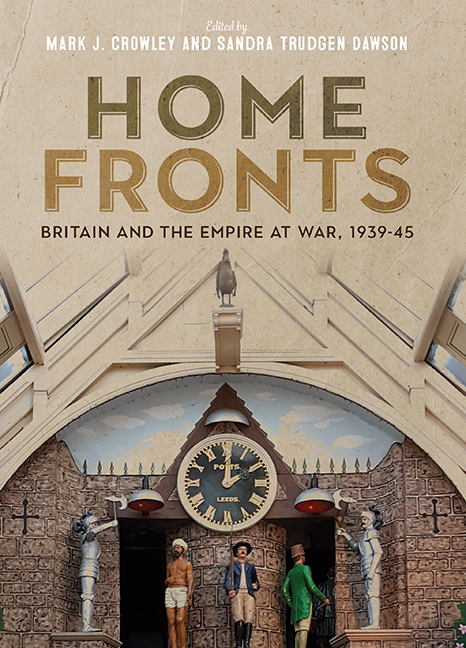Book contents
- Frontmatter
- Dedication
- Contents
- List of Illustrations
- List of Contributors
- Acknowledgements
- List of Abbreviations
- Introduction: Home Fronts and the Empire at War
- Part One Consumption on the Home Front
- Part Two The Militarized Home Front
- 5 ‘Young blood’ and ‘the blackout’: Love, Sex and Marriage on the South African Home Front
- 6 Ceylon's Home Front during the Second World War
- 7 Nyanza at War: Kenya and the Mobilization of Britain's Colonial Empire
- 8 ‘Fighting In Their Ways’? The Civilian Man in British Culture, 1939–1945
- Part Three Technology, Danger and Waste on the Home Front
- Select Bibliography
- Index
8 - ‘Fighting In Their Ways’? The Civilian Man in British Culture, 1939–1945
from Part Two - The Militarized Home Front
Published online by Cambridge University Press: 30 August 2017
- Frontmatter
- Dedication
- Contents
- List of Illustrations
- List of Contributors
- Acknowledgements
- List of Abbreviations
- Introduction: Home Fronts and the Empire at War
- Part One Consumption on the Home Front
- Part Two The Militarized Home Front
- 5 ‘Young blood’ and ‘the blackout’: Love, Sex and Marriage on the South African Home Front
- 6 Ceylon's Home Front during the Second World War
- 7 Nyanza at War: Kenya and the Mobilization of Britain's Colonial Empire
- 8 ‘Fighting In Their Ways’? The Civilian Man in British Culture, 1939–1945
- Part Three Technology, Danger and Waste on the Home Front
- Select Bibliography
- Index
Summary
IN 1946 the British Crown Film Unit, part of the Ministry of Information, released the Humphrey Jennings documentary short A Diary for Timothy (Humphrey Jennings, 1946) which documented the closing months of the Second World War. It contained within it a glowing depiction of Britain's wartime civilian male workers, portraying them as central to the war effort and eventual victory. The narrator, actor Michael Redgrave, declared:
You see this was total war. Everyone was in it. It was everywhere. Not only on the battlefields but in the valleys where Goronwy, the coal miner, carries his own weapons to his own battlefront in scenery which isn't exactly pretty. If you looked across the countryside of England, that is beautiful, you can see Alan, the farmer, he has spent the last five years of war reclaiming the land and making it fertile. He has been fighting against the forces of nature all his life. And now with a mortal enemy on us he has to fight harder than ever. In London Bill the engine driver looks out of his cab at his battlefront. No longer taking holiday makers to the sea but taking the miner's coal, the farmer's crops, the fighting men's ammunitions to where they have to go. Goronwy, Alan and Bill are all fighting in their ways.
The militaristic vocabulary used in describing these workers makes evident the filmmakers’ wish to present them as central components of the war effort and the equals of their counterparts in the fighting forces. Moreover, the production notes for the film confirm that the filmmakers were consciously making parallels between these civilian jobs and the armed forces. The notes portray Bill's occupation as a ‘vital war job’ and, more tellingly, Goronwy is, when injured in a mining accident, described as being in ‘permanent danger as compared with temporary as airmen.
- Type
- Chapter
- Information
- Home Fronts - Britain and the Empire at War, 1939–45 , pp. 146 - 164Publisher: Boydell & BrewerPrint publication year: 2017

